Designing Competitive Nanostore Networks for Enhanced Food Accessibility: Insights from a Competitive Facility Location Model
Abstract
1. Introduction
2. Literature Review
2.1. Proximity Factors and the Role of Nanostores
2.2. Building the Bridge: The Competitive Facility Location Model
2.3. Research Gaps
3. Materials and Methods
3.1. Discrete Choice Model
3.2. Optimization Model for the Location of Nanostores
3.2.1. Coverage
3.2.2. Description of the Competitive Facility Location Problem for Nanostores
3.2.3. Models’ Assumptions
- the distances considered for the model were Euclidean;
- the weekly demand was constructed on the households’ declared demand in the survey;
- the demand was constant, and the initial preferred retailer considered was the one stated in the initial survey;
- the household will always select one retail alternative to purchase;
- the households’ data were extrapolated to the number of existing households in their blocks.
- all nanostores are homogeneous;
- nanostores owners have a fixed operation cost to maintain their inventories. We considered that nanostores would offer other products than fruits and vegetables. From information gathered with nanostore owners, we defined that fresh food should cover at most USD 100 of the total operational costs.
3.2.4. Mathematical Formulation
- Sets
- P = set of products indexed in p;
- = set of households indexed in ;
- = set of existing nanostores indexed in ;
- = set of potential new nanostores indexed in ;
- = set of fruvers indexed in ;
- = set of large supermarket chains indexed in ;
- = set of small supermarkets indexed in ;
- = set of other channels indexed in ;
- = set of potential new nanostores alias indexed in ;
- = Retailers.
- Parameters
- = distance between potential new nanostore and potential new nanostore ;
- = minimum distance required between two potential new nanostores to be opened;
- = maximum distance between household and potential new nanostore ;
- distance between household and retailer ;
- = weekly demand of fresh food in household for product ;
- = ;
- = observed utility of household when selecting retailer for product p, where = ;
- = weight of price of retailer r for product p;
- = weight of distance from household to chosen retailer r for product p;
- = regression coefficient (i.e., intercept) for each retailer for product p;
- = linearization parameter of the constant, where ;
- price in USD per kg of product p in retailer ;
- unit cost in USD per kg of product p in retailer ;
- weekly operation fixed costs in USD of nanostore .
- Variables
- = ;
- : probability of household of choosing retailer to purchase product p;
- : linearized cumulative probability per household to purchase product p;
- = demand captured by nanostore i per product p.
4. The Sabana Centro Case Study
4.1. Data Collection and Model Calibration
Primary Data Collected from Surveys
4.2. Primary Data Collected with Georeferenced Tools
5. Results
5.1. Logit Model
5.2. Competitive Facility Location
Sensitivity Analysis
6. Discussion
6.1. Rethinking Efficiency and Scale in Retail Network Design
6.2. Methodological Contributions and Future Research
7. Conclusions
Managerial and Policy Implications
Author Contributions
Funding
Institutional Review Board Statement
Informed Consent Statement
Data Availability Statement
Acknowledgments
Conflicts of Interest
References
- Migdadi, Y.K.A.A.; Abdel-Rahman, E.H.A. The impact of grocery retail superstores location on the customer’s perceived quality of servicescape in Jordan. Qual. Manag. J. 2020, 27, 120–132. [Google Scholar] [CrossRef]
- Ozuduru, B.H.; Guldmann, J.-M. Retail Location and Urban Resilience: Towards a New Framework for Retail Policy. Surv. Perspect. Integr. Environ. Soc. 2013, 6, 1–13. [Google Scholar]
- Tuomala, V.; Grant, D.B. Exploring supply chain issues affecting food access and security among urban poor in South Africa. Int. J. Logist. Manag. 2022, 33, 27–48. [Google Scholar] [CrossRef]
- Mogil, S.; Hill, E.; Quinlan, J. Characterization of the shopping preferences and needs of low-income consumers living in food deserts. Br. Food J. 2022, 124, 3468–3479. [Google Scholar] [CrossRef]
- Boulaksil, Y.; Fransoo, J.C.; Blanco, E.E.; Koubida, S. Understanding the fragmented demand for transportation–Small traditional retailers in emerging markets. Transp. Res. Part A Policy Pract. 2019, 130, 65–81. [Google Scholar] [CrossRef]
- Fransoo, J.C.; Blanco, E.; Mejía-Argueta, C. Reaching 50 Million Nanostores: Retail Distribution in Emerging Megacities; CreateSpace: Scotts Valley, CA, USA, 2017. [Google Scholar]
- Mejía-Argueta, C.; Benitez-Perez, V.; Salinas-Benitez, S.; Brives, O.; Fransoo, J.C.; Salinas-Navarro, D.; Rangel, G. Nanostores, a Force to Reckon with to Fight Malnutrition. LinkedIn. Available online: https://www.linkedin.com/pulse/nanostores-force-reckon-fight-malnutrition-escf-professors/ (accessed on 17 September 2022).
- Salinas-Navarro, D.E.; Vilalta-Perdomo, E.; Michel-Villarreal, R. Empowering Nanostores for Competitiveness and Sustainable Neighbourhoods in Emergent Countries: A GenAI Strategy Ideation Process. Sustainability 2024, 16, 11244. [Google Scholar] [CrossRef]
- Paswan, A.; de los Dolores Santarriaga Pineda, M.; Ramirez, F.C.S. Small versus large retail stores in an emerging market—Mexico. J. Bus. Res. 2010, 63, 667–672. [Google Scholar] [CrossRef]
- Blanchard, T.C.; Lyson, T.A. Retail Concentration, Food Deserts, and Food Disadvantaged Communities in Rural America. In Remaking the North American Food System: Strategies for Sustainability; Hinrichs, C.C., Lyson, T.A., Eds.; University of Nebraska Press: Lincoln, NE, USA, 2008; pp. 201–215. [Google Scholar]
- Jiménez, F.A. La Pandemia Impulsó a las Tiendas de Barrio, El Colombiano. Available online: https://www.elcolombiano.com/negocios/economia/tiendas-de-barrio-en-colombia-favorecidas-por-la-pandemia-DD14601112 (accessed on 18 August 2022).
- Rangel-Espinosa, M.F.; Hernández-Arreola, J.R.; Pale-Jiménez, E.; Salinas-Navarro, D.E.; Argueta, C.M. Increasing Competitiveness of Nanostore Business Models for Different Socioeconomic Levels. In Supply Chain Management and Logistics in Emerging Markets; Emerald Publishing: Leeds, UK, 2020; pp. 273–298. [Google Scholar] [CrossRef]
- Cannuscio, C.C.; Tappe, K.; Hillier, A.; Buttenheim, A.; Karpyn, A.; Glanz, K. Urban food environments and residents’ shopping behaviors. Am. J. Prev. Med. 2013, 45, 606–614. [Google Scholar] [CrossRef] [PubMed]
- Smith, D.M.; Cummins, S.; Taylor, M.; Dawson, J.; Marshall, D.; Sparks, L.; Anderson, A.S. Neighbourhood food environment and area deprivation: Spatial accessibility to grocery stores selling fresh fruit and vegetables in urban and rural settings. Int. J. Epidemiol. 2010, 39, 277–284. [Google Scholar] [CrossRef]
- Kin, B.; Ambra, T.; Verlinde, S.; Macharis, C. Tackling Fragmented Last Mile Deliveries to Nanostores by Utilizing Spare Transportation Capacity—A Simulation Study. Sustainability 2018, 10, 653. [Google Scholar] [CrossRef]
- Drezner, T.; Drezner, Z.; Suzuki, A. A cover based competitive facility location model with continuous demand. Nav. Res. Logist. 2019, 66, 565–581. [Google Scholar] [CrossRef]
- Drezner, T.; Drezner, Z.; Salhi, S. Solving the multiple competitive facilities location problem. Eur. J. Oper. Res. 2002, 142, 138–151. [Google Scholar] [CrossRef]
- Drezner, T.; Drezner, Z.; Kalczynski, P. Gradual cover competitive facility location. OR Spectr. 2020, 42, 333–354. [Google Scholar] [CrossRef]
- Santorelli, M.L.; Okeke, J.O. Evaluating Community Measures of Healthy Food Access. J. Community Health 2017, 42, 991–997. [Google Scholar] [CrossRef]
- Shier, V.; Miller, S.; Datar, A. Heterogeneity in grocery shopping patterns among low-income minority women in public housing. BMC Public Health 2022, 22, 1612. [Google Scholar] [CrossRef]
- Wainer, A.; Robinson, L.; Argueta, C.M.; Cash, S.B.; Satin-Hernandez, E.; Chomitz, V.R. At the nexus of grocery access and transportation: Assessing barriers and preferences for alternative approaches to enhancing food access. J. Transp. Health 2023, 33, 101712. [Google Scholar] [CrossRef]
- Kim, D.; Lee, C.K.; Seo, D.Y. Food deserts in Korea? A GIS analysis of food consumption patterns at sub-district level in Seoul using the KNHANES 2008–2012 data. Nutr. Res. Pr. 2016, 10, 530–536. [Google Scholar] [CrossRef]
- Ghosh-Dastidar, B.; Cohen, D.; Hunter, G.; Zenk, S.N.; Huang, C.; Dubowitz, T. Distance to store, food prices, and obesity in urban food deserts. Am. J. Prev. Med. 2014, 47, 587–595. [Google Scholar] [CrossRef]
- da Silva-Ovando, A.C.; Granados-Rivera, D.; Mejía, G.; Mejía-Argueta, C.; Jarrín, J. Spatial Analysis of Fresh Food Retailers in Sabana Centro, Colombia. In Engineering Analytics; CRC Press: Boca Raton, FL, USA, 2021; pp. 235–253. [Google Scholar] [CrossRef]
- Davis, K.F.; Downs, S.; Gephart, J.A. Towards food supply chain resilience to environmental shocks. Nat. Food 2021, 2, 54–65. [Google Scholar] [CrossRef]
- FAO; IFAD; UNICEF; WFP; WHO. The State of Food Security and Nutrition in the World 2022; FAO: Rome, Italy, 2022. [Google Scholar] [CrossRef]
- Escamilla, R.; Fransoo, J.C.; Tang, C.S. Improving Agility, Adaptability, Alignment, Accessibility, and Affordability in Nanostore Supply Chains. Prod. Oper. Manag. 2021, 30, 676–688. [Google Scholar] [CrossRef]
- Fan, L.; Baylis, K.; Gundersen, C.; Ploeg, M.V. Does a nutritious diet cost more in food deserts? Agric. Econ. 2018, 49, 587–597. [Google Scholar] [CrossRef]
- Levi, R.; Paulson, E.; Perakis, G. Fresh Fruit and Vegetable Consumption: The Impact of Access and Value; MIT Sloan Research Paper No. 5389-18; MIT Sloan: Cambridge, MA, USA, 2020. [Google Scholar] [CrossRef]
- Villa, S.; Escamilla, R.; Fransoo, J.C. Supplying Cash-Constrained Retailers: Understanding Shopkeeper Behavior at the Bottom of the Pyramid. Manuf. Serv. Oper. Manag. 2024, 26, 2030–2049. [Google Scholar] [CrossRef]
- Ge, J.; Honhon, D.; Fransoo, J.C.; Zhao, L. Supplying to Mom and Pop: Traditional Retail Channel Selection in Megacities. Manuf. Serv. Oper. Manag. 2020, 23, 19–35. [Google Scholar] [CrossRef]
- Palomino, K.; Garcia, D.; Berdugo, C. A MILP facility location model with distance value adjustments for demand fulfillment using Google Maps. J. Eng. Res. 2022, 10, 270–291. [Google Scholar] [CrossRef]
- Ashtiani, M.G. Competitive location: A state-of-art review. Int. J. Ind. Eng. Comput. 2016, 7, 1–18. [Google Scholar] [CrossRef]
- Eiselt, H.A.; Marianov, V.; Drezner, T. Competitive Location Models. In Location Science; Springer International Publishing: Cham, Switzerland, 2015; pp. 365–398. [Google Scholar] [CrossRef]
- Drezner, T.; Drezner, Z.; Zerom, D. An extension of the gravity model. J. Oper. Res. Soc. 2022, 73, 2732–2740. [Google Scholar] [CrossRef]
- Mejía, G.; Aránguiz, R.; Espejo-Díaz, J.A.; Granados-Rivera, D.; Mejía-Argueta, C. Can street markets be a sustainable strategy to mitigate food insecurity in emerging countries? Insights from a competitive facility location model. Socio-Econ. Plan. Sci. 2023, 86, 101456. [Google Scholar] [CrossRef]
- Tong, D.; Ren, F.; Mack, J. Locating farmers’ markets with an incorporation of spatio-temporal variation. Socio-Econ. Plan. Sci. 2012, 46, 149–156. [Google Scholar] [CrossRef]
- Drezner, T. A review of competitive facility location in the plane. Logist. Res. 2014, 7, 1–12. [Google Scholar] [CrossRef]
- Küçükaydın, H.; Aras, N. Gradual covering location problem with multi-type facilities considering customer preferences. Comput. Ind. Eng. 2020, 147, 106577. [Google Scholar] [CrossRef]
- Ahmadi, Z.; Ghezavati, V. Developing a new model for a competitive facility location problem considering sustainability using Markov chains. J. Clean. Prod. 2020, 273, 122971. [Google Scholar] [CrossRef]
- Ahn, H.K.; Cheng, S.W.; Cheong, O.; Golin, M.; Van Oostrum, R. Competitive facility location: The Voronoi game. Theor. Comput. Sci. 2004, 310, 457–467. [Google Scholar] [CrossRef]
- Byrne, T.; Fekete, S.P.; Kalcsics, J.; Kleist, L. Competitive location problems: Balanced facility location and the One-Round Manhattan Voronoi Game. Ann. Oper. Res. 2023, 321, 79–101. [Google Scholar] [CrossRef]
- Höke, B.; Zerri Turgay, Z.; Ünsalan, C.; Küçükaydin, H. Determining and evaluating new store locations using remote sensing andmachine learning. Turk. J. Electr. Eng. Comput. Sci. 2021, 29, 1509–1523. [Google Scholar] [CrossRef]
- Plastria, F. Static competitive facility location: An overview of optimization approaches. Eur. J. Oper. Res. 2001, 129, 461–470. [Google Scholar] [CrossRef]
- Fernández, J.; Redondo, J.L.; Ortigosa, P.M.; Tóth, B.G. Huff-like stackelberg location problems on the plane. In Springer Optimization and Its Applications; Springer: Berlin/Heidelberg, Germany, 2017; Volume 118, pp. 129–169. [Google Scholar] [CrossRef]
- Saidani, N.; Chu, F.; Chen, H. Competitive facility location and design with reactions of competitors already in the market. Eur. J. Oper. Res. 2012, 219, 9–17. [Google Scholar] [CrossRef]
- Pahlavani, A.; Saidi-Mehrabad, M. A competitive facility location model with elastic demand and patronising behaviour sensitive to location, price and waiting time. Int. J. Logist. Syst. Manag. 2011, 10, 293–312. [Google Scholar] [CrossRef]
- Aboolian, R.; Berman, O.; Krass, D. Competitive facility location and design problem. Eur. J. Oper. Res. 2007, 182, 40–62. [Google Scholar] [CrossRef]
- Shan, W.; Yan, Q.; Chen, C.; Zhang, M.; Yao, B.; Fu, X. Optimization of competitive facility location for chain stores. Ann. Oper. Res. 2019, 273, 187–205. [Google Scholar] [CrossRef]
- Méndez-Vogel, G.; Marianov, V.; Fernández, P.; Pelegrín, B.; Lüer-Villagra, A. Sequential customers’ decisions in facility location with comparison-shopping. Comput. Oper. Res. 2024, 161, 106448. [Google Scholar] [CrossRef]
- Roudsari, A.H.; Wong, K.Y. A bi-objective stochastic single facility location model for a supermarket. Int. J. Serv. Oper. Manag. 2014, 17, 257–279. [Google Scholar] [CrossRef]
- Wang, X.; He, H.; Zhang, Z.; Zhao, M. Bi-level optimization model of O2O fresh product experience store location considering service quality. Procedia. Comput. Sci. 2019, 159, 1767–1776. [Google Scholar] [CrossRef]
- Satani, N.; Uchida, A.; Deguchi, A.; Ohgai, A.; Sato, S.; Hagishima, S. Commercial facility location model using multiple regression analysis. Comput. Environ. Urban. Syst. 1998, 22, 219–240. [Google Scholar] [CrossRef]
- Widaningrum, D.L. GIS and SVM approach for convenience store location analysis. In ICMLC ’17: Proceedings of the 9th International Conference on Machine Learning and Computing; ACM International Conference Proceeding Series; Association for Computing Machinery: New York, NY, USA, 2017; Volume Part F1283, pp. 112–116. [Google Scholar] [CrossRef]
- Kalczynski, P.; Drezner, Z.; O’Kelly, M. Multi-facility location models incorporating multipurpose shopping trips. OR Spectr. 2025, 47, 455–475. [Google Scholar] [CrossRef]
- Krizek, K.J.; Johnson, P.J. Proximity to trails and retail: Effects on urban cycling and walking. J. Am. Plan. Assoc. 2006, 72, 33–42. [Google Scholar] [CrossRef]
- Oded, B.; Celik, P. Sequential facility location with distance dependent demand. J. Oper. Manag. 1982, 2, 261–268. [Google Scholar] [CrossRef]
- Na, H.; Kim, S.; Langellier, B.A.; Son, Y.-J. Famers Markets Location-Allocation Framework for Public Health Enhancement. In Proceedings of the IIE Annual Conference and Expo 2015, Nashiville, TN, USA, 30 May–2 June 2015; pp. 1205–1214. Available online: https://experts.arizona.edu/en/publications/famers-markets-location-allocation-framework-for-public-health-en (accessed on 24 May 2025).
- Arentze, T.A.; Borgers, A.W.J.; Timmermans, H.J.P. The integration of expert knowledge in decision support systems for facility location planning. Comput. Env. Urban. Syst. 1995, 19, 227–247. [Google Scholar] [CrossRef]
- Manatkar, R.P.; Karthik, K.; Kumar, S.K.; Tiwari, M.K. An integrated inventory optimization model for facility location-allocation problem. Int. J. Prod. Res. 2016, 54, 3640–3658. [Google Scholar] [CrossRef]
- Train, K.E. Discrete Choice Methods with Simulation; Cambridge University Press: Cambridge, UK, 2001. [Google Scholar] [CrossRef]
- Ben-Akiva, M.; Lerman, S. Discrete Choice Analysis: Theory and Application to Travel Demand; The MIT Press: Cambridge, UK, 1985; Available online: https://mitpress.ublish.com/book/discrete-choice-analysis-theory-and-application-to-travel-demand?purchase (accessed on 18 September 2022).
- Bierlaire, M. A Short Introduction to Biogeme; Technical Report TRANSP-OR 230620; EPFL: Lausanne, Switzerland, 2023; Available online: https://biogeme.epfl.ch/ (accessed on 24 May 2025).
- Haase, K.; Müller, S. A comparison of linear reformulations for multinomial logit choice probabilities in facility location models. Eur. J. Oper. Res. 2014, 232, 689–691. [Google Scholar] [CrossRef]
- DANE, Geoportal DANE, Geoportal DANE. Available online: https://geoportal.dane.gov.co/servicios/descarga-y-metadatos/datos-geoestadisticos/?cod=111 (accessed on 5 July 2023).
- Ardila Medina, W.A. Categorías y Surtidos Que Caracterizan a Las Tiendas de Barrio de la Localidad de Barrios Unidos de Bogotá, Bogotá. 2016. Available online: https://libros.ucentral.edu.co/index.php/editorialuc/catalog/book/384 (accessed on 17 September 2022).
- Hall, J.N.; Moore, S.; Harper, S.B.; Lynch, J.W. Global variability in fruit and vegetable consumption. Am. J. Prev. Med. 2009, 36, 402–409.e5. [Google Scholar] [CrossRef]
- Das, S. Delivering Locally Sourced Nutritious Food to Indian Households; Massachusetts Institute of Technology: Cambridge, MA, USA, 2021; Available online: https://dspace.mit.edu/bitstream/handle/1721.1/139392/das-sanchdas-meng-scm-2021-thesis.pdf?sequence=1 (accessed on 4 July 2023).
- Matos-Cámara, R.F.; Ochoa-Hernández, M.L.; Huerta-Zavala, P.A. Social Marketing Actions in Small-Format Convenience Stores: The Case of Oxxo in Mexico. In Applying Quality of Life Research; Springer: Cham, Switzerland, 2022; pp. 393–403. [Google Scholar] [CrossRef]

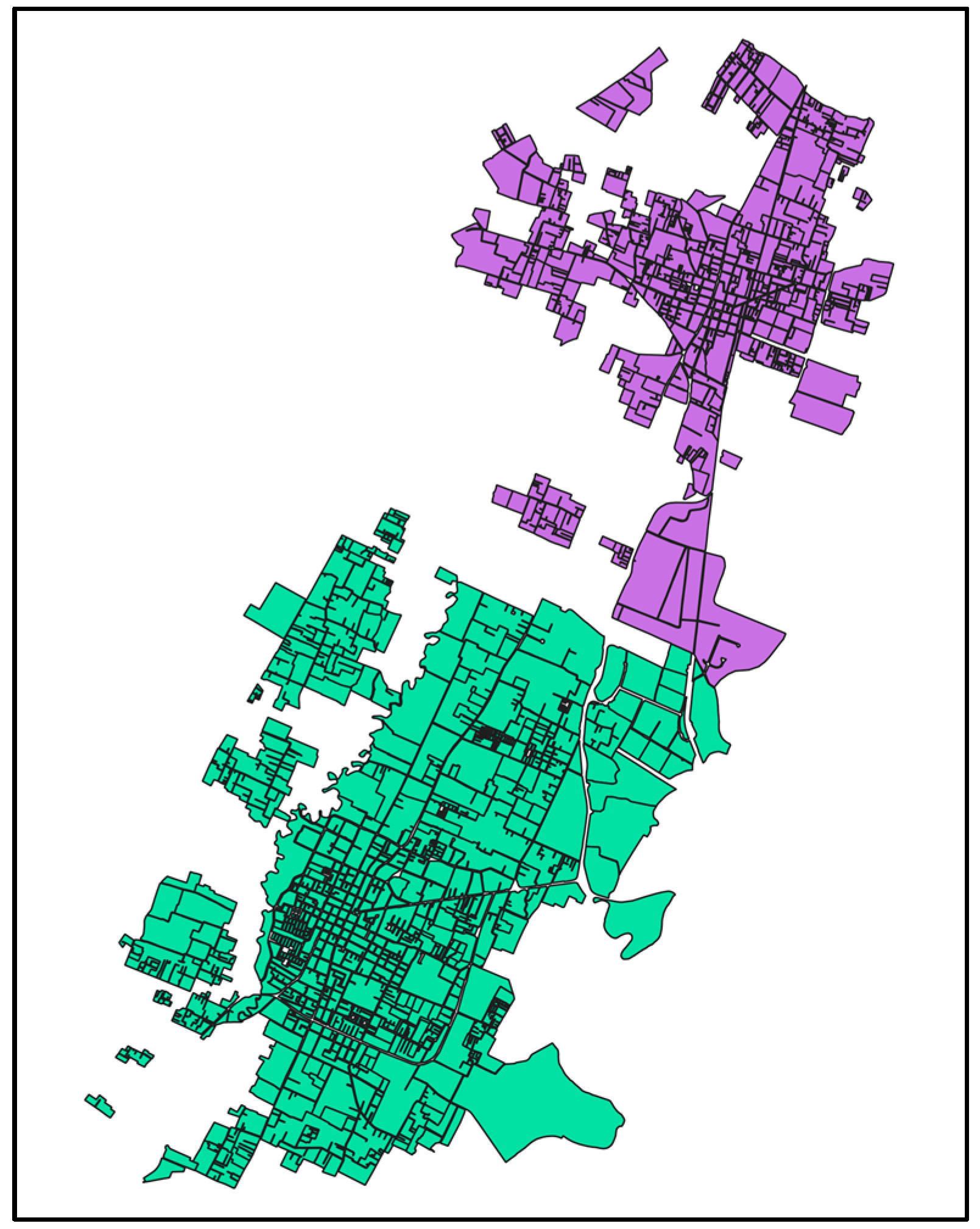
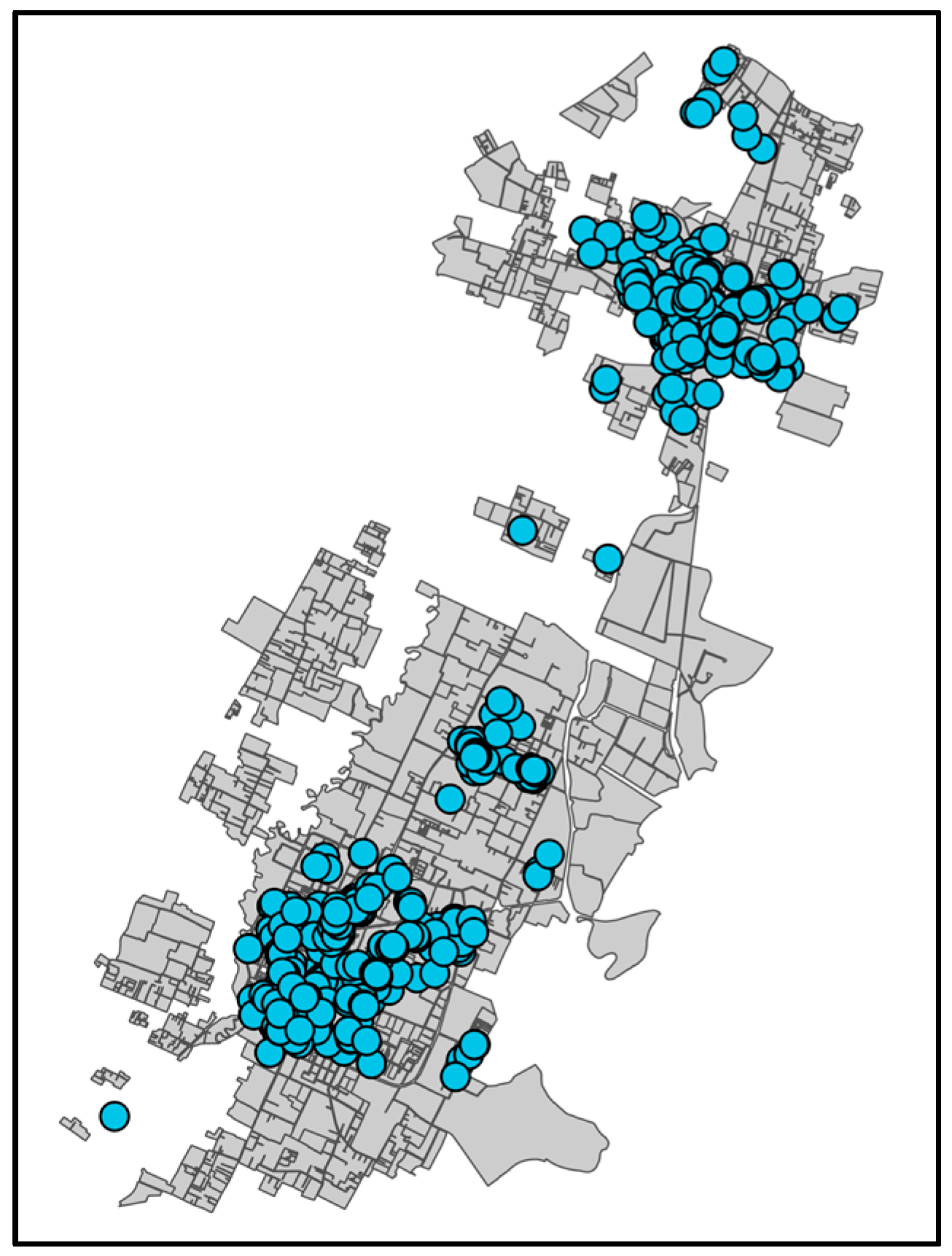
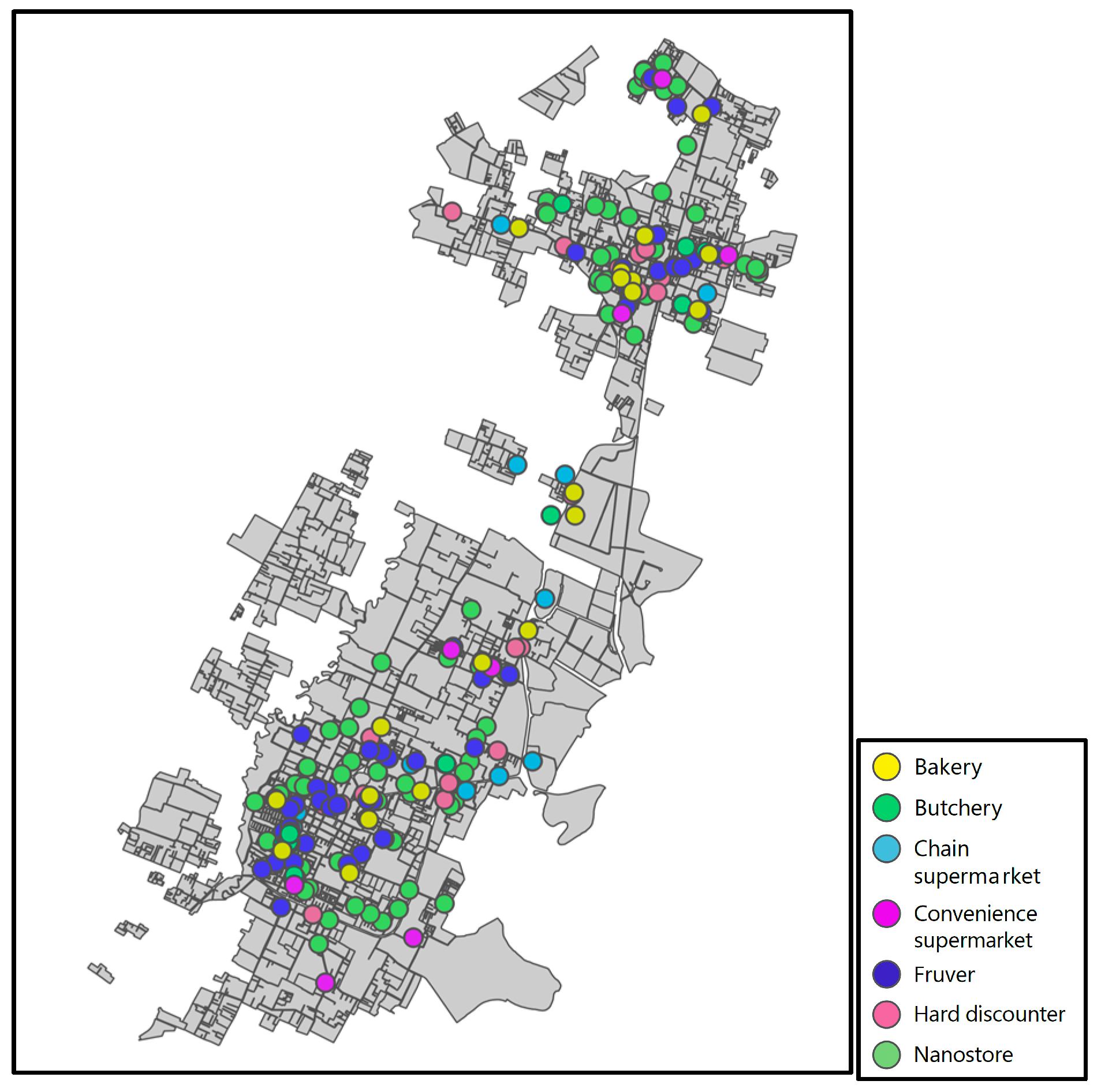
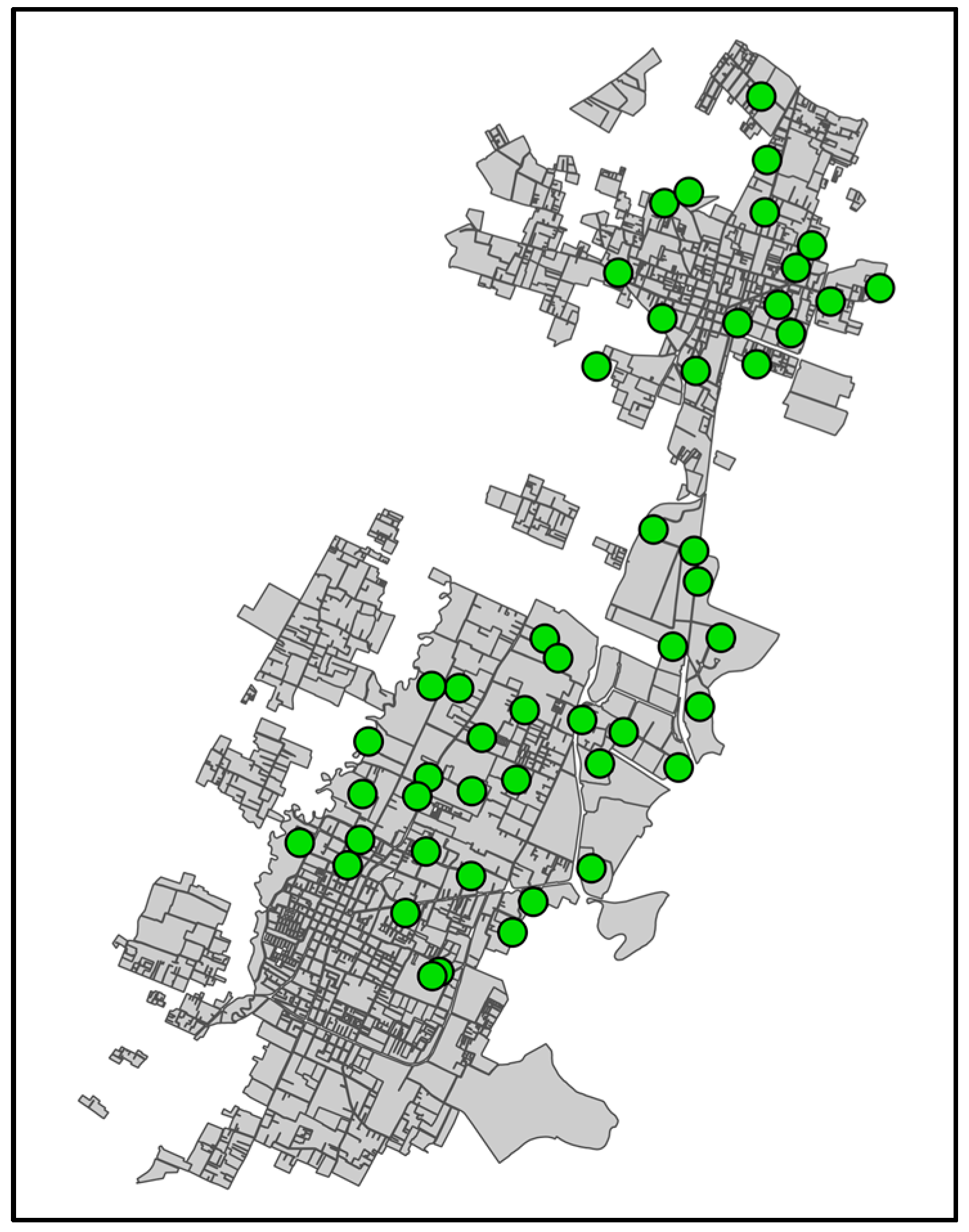
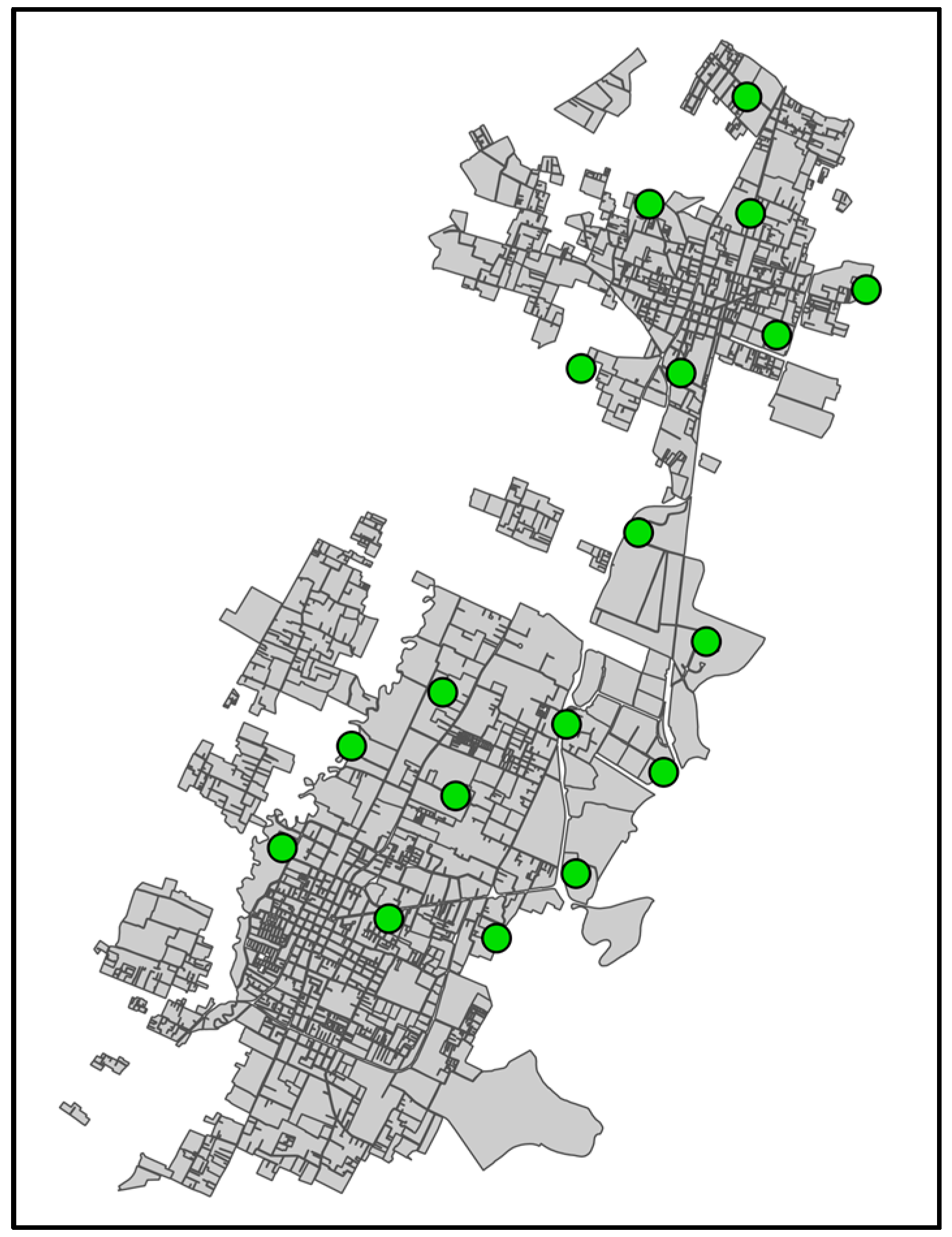

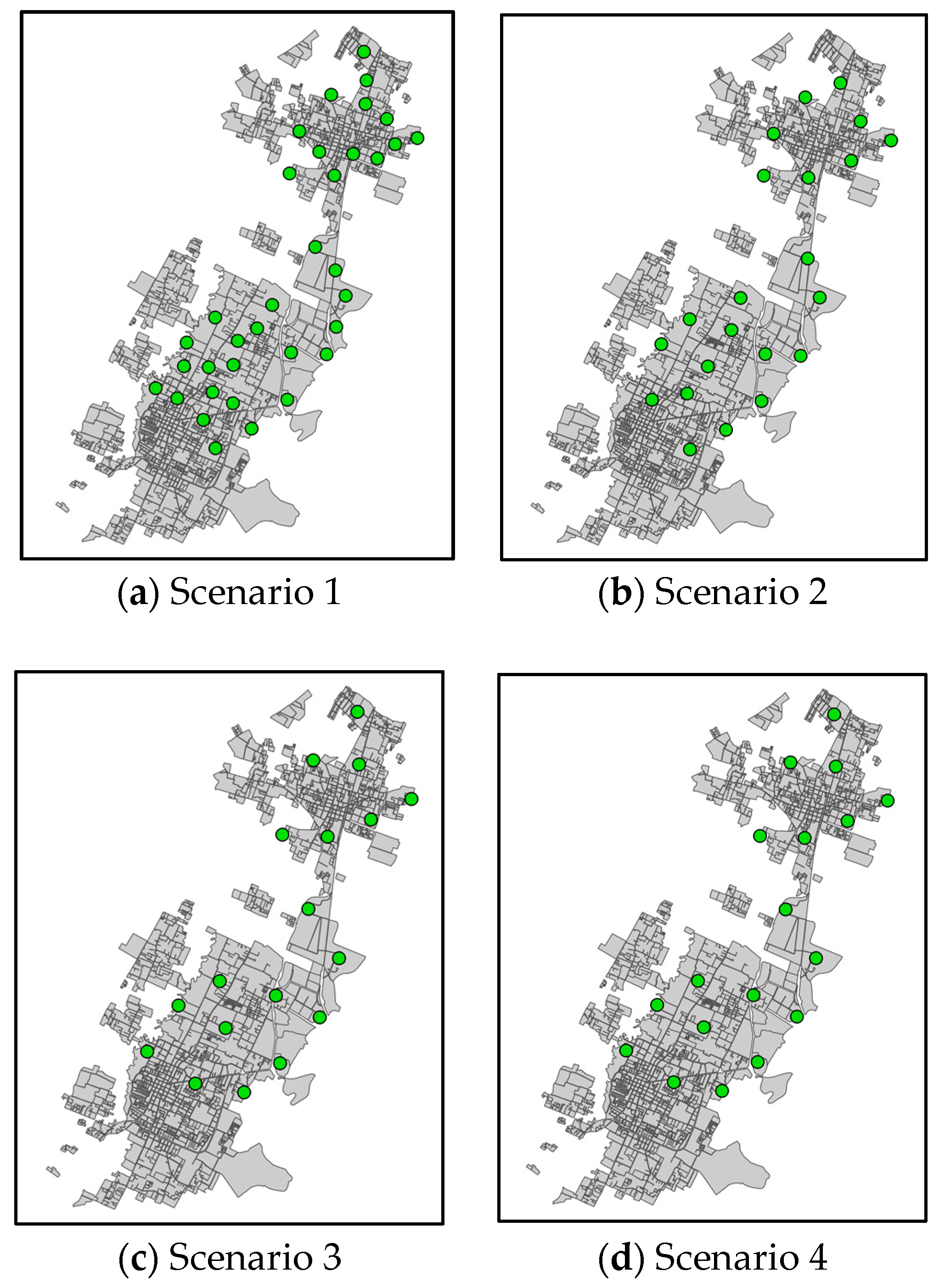

| Reference | Type of Retail | Type of Products | Region | Approach |
|---|---|---|---|---|
| Palomino et al. [32] | Chain Store | Products in the food category | Colombia | Optimization of food distribution networks to improve cost efficiency, reduce travel distances, and ensure store demand fulfillment. |
| Roudsari and Wong [51] | Supermarket chain | Essential goods | Iran | Identification of an optimal supermarket location based on customer proximity and minimal surrounding competition. |
| Wang et al. [52] | O2O Fresh Produce Experience Store | Fresh produce | Unspecified (conceptual model) | Modeling optimal siting for fresh produce stores with integrated retail and delivery functions. |
| Fernandez [45] | Supermarkets | General products in supermarkets | Spain (“pseudo-real” application) | Analysis of store placement strategies to maximize profit under competitive pressure and potential cannibalization. |
| Satani et al. [53] | Convenience stores | Convenience goods (including food) | Japan | Estimation of retail employment and floor area using Huff model parameters for food store trade areas. |
| Höke et al. [43] | Food stores, supermarkets, boutique stores | Food Products | Turkey | Site selection for food retailers using remote sensing and AI to enhance revenue prediction. |
| Widaningrum [54] | Convenience Stores | Convenience products | Indonesia | Spatial analysis of convenience store placement, emphasizing public facility access and urban form. |
| Kalczynski et al. [55] | Multiple facilities of a chain, grocery stores | Miscellaneous products | Unspecified (conceptual model) | Location optimization based on multipurpose shopping behavior, improving accuracy and limiting cannibalization. |
| Kizek and Johnson [56] | Neighborhood retail establishments | Food and beverages | USA | Assessment of proximity effects on active travel near food retailers, informing location guidelines. |
| Oded and Celik [57] | Fast food stores, grocery stores, convenience stores | Fast food services, groceries, convenience products | Unspecified (conceptual model) | Evaluation of new facility impact on network demand, with emphasis on distance-sensitive markets. |
| Mejía et al. [36] | Mobile markets | Fresh food | Chile | Evaluation of the impact of adding new street markets to satisfy the demand of end consumers. |
| Na et al. [58] | Farmer markets | Fresh food | USA | Location-allocation framework evaluates how farmers market pricing policies and their interaction with other food retailers to improve food distribution. |
| Arentze et al. [59] | Large-scale retail facilities, retail chains, supply of daily retail goods | Daily retail goods | Unspecified (conceptual model) | Integration of expert systems in retail location planning to balance service reach and economic viability. |
| Model | ||
|---|---|---|
| (5) | ||
| , | (6) | |
| (7) | ||
| (8) | ||
| (9) | ||
| (10) | ||
| Parameter | Value |
|---|---|
| Minimum distance required between two potential new nanostores to be opened | 1000 m |
| Maximum distance between household and potential new nanostore | 12,388 m |
| Unit cost of fruits for retailer (USD/kg) | 0.88 USD/kg |
| Unit cost of vegetables for retailer (USD/kg) | 0.75 USD/kg |
| Unit cost of tubers for retailer (USD/kg) | 0.58 USD/Kg |
| Unit selling price of fruits (USD/kg) | 0.98 USD/kg |
| Unit selling price of vegetables (USD/kg) | 1.05 USD/kg |
| Unit selling price of tubers (USD/kg) | 0.94 USD/Kg |
| Weekly operation fixed costs of nanostore selected (USD) | 100 USD |
| Retail Channel | Fruits | Vegetables | Tubers | ||||||
|---|---|---|---|---|---|---|---|---|---|
| Nanostores | 4.81 ** | 1.17 ** | −0.07 | 4.32 ** | 0.05 | −0.04 | 4.51 ** | −0.16 * | 0.02 |
| Fruvers | 0 | −0.11 | −1.68 | 0.45 * | 0.04 * | 0.11 | 0.2 | 0.17 | −0.67 |
| Large supermarkets | 0 | 0.2 | 0.31 | 0.19 | 0.22 | −0.02 | −0.36 | 0.08 | 0.58 |
| Convenience supermarkets | −0.63 ** | 1.36 ** | −0.21 * | 3.78 ** | −0.3 ** | −0.18 * | 3.99 ** | −0.05 * | −0.26 ** |
| Hard discounters | −0.87 ** | 1.36 ** | 0.38 ** | 3.53 ** | −0.29 ** | 0.39 ** | 3.7 ** | −0.04 * | 0.32 ** |
| Detail | Value |
|---|---|
| Objective function (USD) | 22,174 |
| Optimality gap | 0.01 |
| Computational time (h) | 1.09 |
| New nanostores opened | 18 |
| Total demand captured (kg/week) | 65,401 |
| Scenario | 1 | 2 | 3 | 4 |
|---|---|---|---|---|
| Minimum distance (m) | 500 | 750 | 1000 | 1000 |
| Demand variation (%) | 0% | 0% | −25% | +25% |
| Objective function (USD) | 36,216 | 25,943 | 15,292 | 29,079 |
| Optimality gap | 0.01 | 0.07 | 0.01 | 0.01 |
| Computational time (h) | 1.66 | 0.55 | 0.91 | 0.89 |
| New nanostores opened | 35 | 22 | 18 | 18 |
| Total demand captured (Kg/week) | 110,809 (27% of total demand) | 77,186 (19% of total demand) | 49,079 (12% of total demand) | 81,778 (20% of total demand) |
Disclaimer/Publisher’s Note: The statements, opinions and data contained in all publications are solely those of the individual author(s) and contributor(s) and not of MDPI and/or the editor(s). MDPI and/or the editor(s) disclaim responsibility for any injury to people or property resulting from any ideas, methods, instructions or products referred to in the content. |
© 2025 by the authors. Licensee MDPI, Basel, Switzerland. This article is an open access article distributed under the terms and conditions of the Creative Commons Attribution (CC BY) license (https://creativecommons.org/licenses/by/4.0/).
Share and Cite
da Silva-Ovando, A.C.; Granados-Rivera, D.; Mejía, G.; Mejía-Argueta, C.; Gutiérrez-Franco, E. Designing Competitive Nanostore Networks for Enhanced Food Accessibility: Insights from a Competitive Facility Location Model. Logistics 2025, 9, 118. https://doi.org/10.3390/logistics9030118
da Silva-Ovando AC, Granados-Rivera D, Mejía G, Mejía-Argueta C, Gutiérrez-Franco E. Designing Competitive Nanostore Networks for Enhanced Food Accessibility: Insights from a Competitive Facility Location Model. Logistics. 2025; 9(3):118. https://doi.org/10.3390/logistics9030118
Chicago/Turabian Styleda Silva-Ovando, Agatha Clarice, Daniela Granados-Rivera, Gonzalo Mejía, Christopher Mejía-Argueta, and Edgar Gutiérrez-Franco. 2025. "Designing Competitive Nanostore Networks for Enhanced Food Accessibility: Insights from a Competitive Facility Location Model" Logistics 9, no. 3: 118. https://doi.org/10.3390/logistics9030118
APA Styleda Silva-Ovando, A. C., Granados-Rivera, D., Mejía, G., Mejía-Argueta, C., & Gutiérrez-Franco, E. (2025). Designing Competitive Nanostore Networks for Enhanced Food Accessibility: Insights from a Competitive Facility Location Model. Logistics, 9(3), 118. https://doi.org/10.3390/logistics9030118








